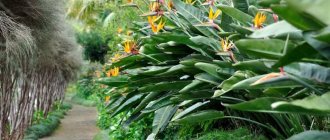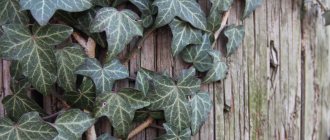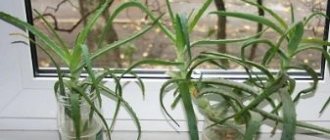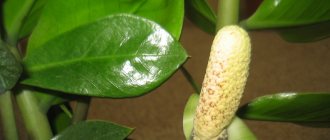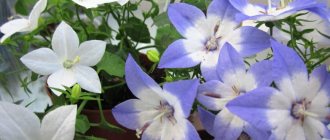Bamboo
How to grow hazelnuts: propagation, planting, care, flowering, harvest
If you want to grow bamboo at home, then you should familiarize yourself with some recommendations for caring for this plant, which you will find below.
general characteristics
Bamboo is a tropical plant that belongs to the cereal family. It grows wild on almost every continent except Europe. It was originally discovered in the mountainous regions of Asia, where temperatures can drop to -30°C. This is one of the reasons why bamboo is so hardy that the European climate is perfect for it.
There are a number of tropical bamboo species that require warm climates and are native to Africa and Australia. The main differences between the species are the root system. Gardeners should take this into account in order to choose the ideal bamboo for their climate.
All bamboo root systems contain rhizomes, which are underground stems with nodes where new shoots grow. They develop depending on the size of the space between the nodes of the rhizome. When choosing a plant, consider the space you have.
How to plant bamboo
Another way to keep your plant from spreading too much is to build a shallow trench (45cm deep is enough) around your bamboo plants. Simply trim off any expanding rhizomes as they enter the trench.
The best time to plant bamboo is spring. If you bought your bamboo from a nursery, you will find that the roots are too attached to the pot, sometimes having to be removed with a knife.
Choose a container at least 45 cm deep and in diameter. Add water retention gel and controlled release fertilizer granules to your compost. Before planting, you need to soak the roots. Then dig a hole that will be one and a half times deeper and twice as wide as the roots themselves.
For best results, add drainage material and organic fertilizer or manure to the base of the planting hole. After planting, water well and mulch with manure, compost or mold.
Bamboo care
Bamboo is not difficult to maintain. This is one of the reasons that accounts for their high popularity. Water and fertilize it well for the first two years. The better you do this, the better it will grow. Avoid salt-based fertilizers as bamboo does not tolerate salt.
Remove weak and dead canes down to the base using scissors or pruning shears. Remove fallen leaves and trim foliage at the base to keep the plant looking neater. Bamboo likes moist, well-drained conditions, so water it regularly.
To encourage healthy growth, regularly prune away dull and weak parts of the plant. This will allow air flow and sunlight to penetrate better into the center of the plant, helping it grow better. Bamboo should be separated every few years to encourage new growth. Cut off old roots and canes, leaving only new shoots.
In summer, water it regularly and fertilize it with liquid compost. In winter, reduce watering and stop feeding, but do not let the plant dry out. At low temperatures, create a greenhouse using film.
Author -
Anastasia Talakh
Like and subscribe to
the channel so as not to miss other interesting articles!
Source
Happy place in the apartment
It is best to place a vase with bamboo on the eastern side of the window or closer to it. You should not leave it on a sunny windowsill, because direct rays of the sun will burn the leaves. The ideal place for bamboo in water is in partial shade. If there are no such places in the apartment, then you can place a vase with bamboo on the windowsill or floor, covering the glass with a curtain, blinds or newspaper, protecting the plant from sunburn. When ventilating the room, the plant should not be exposed to cold air, as this will have a negative effect on it.
How to twist the stem?
Indoor bamboo: looking at the most important care items
How to twist indoor bamboo into a spiral? It is this quality that Sander bamboo is famous for. You can create various decorative compositions from it. It has a curved stem that does not grow leaves. You can give bamboo different shapes yourself. It turns out to create original, spectacular exhibitions.
You need to push the bamboo into the curved tube. The plant should be left in this form for several weeks. During this time, the bamboo will acquire the stable shape set initially. After removing the tube, the bamboo will not change its appearance.
If the shoots are still young and have not yet become woody, you can bend them in different directions. They are secured with wire. After a few weeks, the clamps are removed. The stem will be fixed in a given position and take on the desired shape.
Sander bamboo is definitely worth twisting. Otherwise, it will not look impressive. On its own, this plant grows tall without presenting high decorative value.
How to water Sander bamboo? If it grows in hydrogel, you will rarely need to add liquid to the flowerpot.
Caring for bamboo at home
Growing bamboo at home is not difficult. Technologies differ depending on whether it grows in water or soil. Some varieties are grown both ways.
Temperature
The flower grows best at temperatures from 18 to 25 degrees Celsius. The plant tolerates hot weather easily. Most varieties have good frost resistance, but it is not recommended to overcool the plant.
Lighting
Optimal for the plant is diffused light. It is usually created using a curtain or curtain. A lack of light will cause the flower to turn yellow and its leaves to fall off, which will negatively affect its appearance and decorative properties.
Bamboo care
Watering
It is recommended to water the plant only with settled rainwater. In spring and summer, a lot of moisture is required. Plants with wide leaves need to be watered 2 times a week, those with narrow leaves - at least once every two days. In winter and autumn, the frequency of watering should be significantly reduced (up to once a week).
Important! Tap water is not suitable for irrigation. It contains a large number of various harmful impurities
They have a negative impact on photosynthesis processes. The plant will begin to turn yellow, lose leaves, and become susceptible to various diseases and insect attacks.
Spraying
Professional flower growers recommend spraying the plant 2 times a week. This allows you to maintain a natural level of humidity. In addition, this is an element of hygiene. Wiping and spraying the leaves protects the grass from pests.
Humidity
Most varieties are unpretentious to the level of humidity in the room. They grow equally well in conditions of normal and low humidity. Some varieties require the creation of a special microclimate in the room.
Growing bamboo in soil
The plant can be grown well in soil. Any mixture for growing bamboo is suitable; the plant does not have any special requirements for the soil. It requires timely and good watering, as well as periodic feeding. Regular soil changes may not be necessary.
Growing bamboo in water
A special feature of the plant is that it can be planted in water. This technology is simple, but requires compliance with some rules:
The water should be soft. Usually either rainwater or melt water is used.
Note! You can prepare melt water yourself. To do this, fill a container with tap water, freeze until it becomes ice, then defrost.
All harmful impurities and bacteria will die after such treatment.
Bamboo in water
- The water in the container should be changed at least once a week.
- It is necessary to regularly fertilize the water.
- The container in which to plant a flower can be anything: a flower pot, a vase or a simple jar.
- The vessel must be placed in a well-lit place.
Feeding
The frequency of fertilization depends on the growing method. When cultivating a plant in water, it should be fed once a week at the time of changing the water (you can use a hydrogel, which will simplify care). If the soil growing method is chosen, it is recommended to apply fertilizers once every 2-3 months. Special mineral mixtures for dracaenas should be used.
Bamboo trimming
This procedure is very important for the formation of a decorative form. Another reason to prune bamboo is for flowering. Immediately after it finishes blooming, the plant will dry out. It is necessary to trim the flower in a certain sequence:
- Removing dry branches;
- Trimming excess shoots;
- Removing unsightly stems and those that have grown above the desired height.
The cutting area must be treated with a special varnish, otherwise unsightly growths may form there or pests may appear there.
Transfer
To ensure a comfortable microclimate and growth for young bamboo, it is recommended to plant it. This should be done annually. To replant a bush, you need to prepare the soil. It is enough to mix ½ part of turf soil with equal parts of leaf soil and peat.
Watering
Decorative bamboo needs a moist environment . Watering should be abundant and frequent, especially in summer. In winter, plant development stops and watering can be reduced slightly. But the earthen lump should always be moist. Melt or rainwater is also needed for irrigation
does spraying . It is important for him to regularly wipe the trunk, leaves with a damp cloth and remove dust.
To get a strong plant, you need to properly care for and trim the orchid after flowering.
Orchids can be propagated by children, as you can learn from our article.
Diseases and pests
If not properly cared for, bamboo gets sick:
- If spots and white dots appear on the stems, then the plant is suffering from a fungus. It is necessary to treat the plant with fungicides and ventilate the room more often, while avoiding drafts.
- Like all houseplants, bamboo is susceptible to aphids and mites. If these unpleasant insects have already appeared, you need to wipe the stems and leaves with a sponge dipped in soapy water and treat with insecticides.
- Yellowing of shoots and leaves can be caused by many environmental factors - bright rays of the sun, stagnation of moisture in the roots, frostbite of the roots, too hard water. Yellowed leaves should be removed and the plant should be properly cared for.
- If the bamboo has stopped growing, it may need feeding or too little light. It is necessary to analyze the conditions of detention.
- If the leaves curl and fall off, the temperature in the room is too low and needs to be increased.
- White pigmentation appeared on the leaves. This does not always indicate a disease. It may be a type of bamboo with white flecks.
- If mold appears on the roots, it means the soil is too moist. This should not be allowed, since mold is the first enemy of indoor bamboo.
Reproduction
Dracaena Sandera does not reproduce . Generally, the easiest way to propagate a bamboo houseplant is through pruning. Both stems and strong shoots are suitable for this purpose.
The good thing about bamboo is that its stems can be shaped into intricate spirals. To do this, you will have to cut off the shoots; they are used to propagate the plant.
shoots of indoor bamboo can be placed in water until new roots appear. You can plant them immediately in the ground, but provide more intense lighting and abundant watering.
Less commonly used is propagation by dividing the root system . This procedure is undertaken while indoor bamboo is being planted. In this case, you can also put the new plant in water or plant it in the soil.
Video: planting and caring for decorative bamboo
Dracaena Sandera or Lucky Bamboo is a fairly common indoor plant. It is believed that indoor luck bamboo can bring good luck and wealth to its owners.
Being a very unpretentious plant, bamboo can grow indoors for many years, growing up to 2-3 meters in size with proper care. At the same time, Sander's dracaena is very simple and easy to propagate at home from lateral and apical shoots, of which dracaena produces a large number.
So, we present to you step-by-step instructions with photos for propagating lucky bamboo (Dracaena Sander) at home.
- We choose healthy bamboo stems with shoots 10-15 cm long. It is very easy to identify a healthy stem - it is green and hard. If the stem turns yellow, darkens, or is soft to the touch, it is best not to use it for propagation. An example of healthy stems can be seen in the photo:
Next, remove excess leaves from the stems. It is best to leave only the top few leaves on the shoot. This will allow the bamboo to devote all its energy to root growth.
Cut off the shoot from the main stem. The easiest way is to cut it along the top edge of the main bamboo stem (see photo). It should be noted that the cut shoots must have at least one node (a thickening on the dracaena trunk), from which the roots of a new plant will then grow.
We place the cut off shoots of Dracaena Sandera in a container of water so that they take on new roots. This is usually not a quick process and can take two to three months. In this case, you should regularly change the water in the container to avoid the death of the plant. In this case, the water should be purified as best as possible (after the filter).
If you want new shoots to form on the old stem, then you need to cut it 1-2 cm below the cut shoot, but to the first node on the stem. It is from this node that a new bamboo shoot is formed after 1-2 months.
To prevent rotting of the top of the cut dracaena stem, it is necessary to treat it with wax. To do this, take an ordinary wax candle, melt a small piece of wax over the fire (it is best to do this in a tablespoon), and then lower the top of the plant into it. You should not keep it in wax for a long time, a couple of seconds is enough. After this, the top will be covered with a thin layer of wax, which will give it a good appearance and prevent it from drying out and various types of infections and bacteria getting into it.
Reproduction of bamboo at home is completely different from what its wild namesake needs. The difference lies in the fact that they are not related. The indoor beauty is not a grass. This is a type of such a common flower for home use as dracaena.
It is difficult to imagine that a bare stem with several shoots and leaves, growing straight or twisting in a spiral, can be propagated in any way. And yet it is so. Otherwise, flower nurseries could not boast of the diversity of this species. Learning the technique is easy and possible.
Propagation of bamboo by cuttings at home
Dracaena should be propagated by cuttings in the spring. For planting, it is necessary to use young branches that appear on a plant that has reached maturity. Planting material should be separated from the stem and planted in the ground so that it takes root.
The soil mixture for rooting should be the same as for planting the plant. Since bamboo grows very quickly, roots will appear within a month. The pot for cuttings should be spacious and medium in height, since after some time it will be completely filled with the roots of the planting material.
To make propagation easier, it is often combined with replanting mature bamboo, which is carried out once a year. The growing season is not only a favorable time for transplantation, but also for cuttings. Also, do not forget that after transplanting the cuttings into the ground, they should be carefully looked after in order to avoid problems with the growth and development of young plants in the future.
Indoor bamboo: general information
Indoor bamboo does not require complex care; if the growing requirements are met, it can grow up to 25 cm in length.
If the culture is kept in a liquid medium, then it needs to be changed every 12-14 days. The liquid is pre-settled.
Dracaena bamboo
Use for interior decoration
Specialists use culture to complete the main interior. It easily combines with ceramic figurines and dishes, allowing you to create a unique style in the room. The plant does not require a certain air humidity and can be installed in any corner, even a dimly lit one.
Specimens are grown in soil or liquid and are suitable for creating an Asian-style effect. Medium-sized individuals are used as a living wall - to divide the room into zones.
For reference! Why is it better to replant the plant in a substrate after purchasing it at a flower shop: this will increase its chances of survival.
Bamboo in the interior
The magical properties of indoor bamboo
According to beliefs, bamboo at home can influence certain aspects of life. Magical properties depend on its exact location in the apartment:
- in the southeast corner - attracts financial well-being;
- eastern part - helps to achieve family harmony, get rid of quarrels and mistrust;
- southwestern - will evoke a romantic mood and improve relations between spouses.
Important! Installation of a flowerpot with bamboo must be carried out strictly according to Feng Shui
Briefly about the history of appearance
Under natural conditions, the culture is found in tropical forests of Asian, Australian, African and South American lands. The shrub was widely used as a building material or medicine. Some varieties were used for food.
Dwarf subspecies
The modern world has preferred to use bamboo in interior design. The flexible trunk allows you to create decorative elements from it, form a living wall - if necessary, divide the space into several small corners.
Growing Basics
Indoor bamboo is unpretentious, but requires compliance with fairly simple rules for caring for it. First of all, indirect sunlight, a little coolness and periodic ventilation of the room where it grows.
In winter, the bamboo of happiness should be kept at a temperature of at least 12, and preferably 14-16 degrees. A comfortable room temperature for him is about 22 degrees. At temperatures above 35 it dies. Does not require constant spraying, occasionally it is worth wiping the leaves from dust. Pebbles or expanded clay of various sizes are placed at the bottom of a vase with water. Special mineral fertilizers for dracaenas are used as feeding.
It is recommended to feed bamboo every three months. If fertilized regularly, the leaves and stems will remain green throughout the life of the bamboo. Yellowed leaves and stems should be cut off, the cut area should be allowed to dry and lubricated with soft wax.
What are the benefits of domestic palm trees?
Once in an apartment, a home palm tree can become the main decoration. What made this houseplant so popular?
- The plant is not demanding on growing conditions. You don't need to understand the intricacies of botany to grow a beautiful indoor palm tree.
- A big plant means more oxygen.
There are many varieties of this plant, from which you can choose the one that best suits your specific growing conditions. These are palms for warm rooms, moderately warm and cool.
The domestic palm tree is suitable for growing and propagation in any climate zone. Even in winter, it does not need to create special conditions, just protect it from dry air.
Introduction
Dracaena sanderiana got its nickname for its resemblance to bamboo, but belongs to a different plant family. It blooms very rarely, with white flowers with a sweet aroma. An erect stem with long green leaves reaches a height of 2 meters, but in apartments it often grows to 0.7-1 m. And bamboo became “lucky” thanks to Asian culture, in which it is considered a symbol of success and good luck. But the correct name of the plant did not catch on and all over the world it is called the bamboo of happiness.
How to replant a plant in open ground
Landscape designers often use bamboo to design suburban areas and parks. Bamboo looks especially original next to ponds and artificial reservoirs. In decoration, as a rule, bush varieties are used so that bamboo does not grow too much.
Transplantation is carried out in May-June, as this plant loves a warm and humid climate.
Only adult plants are planted in open ground; before planting, the following activities are carried out:
- You need to choose a suitable variety of bamboo that matches the climate zone.
- Choose a suitable place for planting: sunny, not shaded.
- Bamboo loves chernozem and loamy soils, loose, with good water permeability.
- Before planting, it is advisable to mix nutrient components into the soil: humus or ready-made fertilizers.
- Before planting, bamboo needs to be soaked in water for an hour.
How to replant bamboo:
- Dig a hole for planting, as deep as the rhizome (earthen ball on the roots), and twice as wide as the rhizome.
- Pour soil with humus into the bottom of the hole.
- Place the plant in the hole along with a lump of earth (if the roots are in a container, then together with the container).
- Carefully remove the earthen ball from the container and cover the roots with soil.
- Lightly compact and water.
The roots of decorative bamboo are located on the surface, so the bushes can be damaged by strong winds. Thus, it is better to protect the bushes with garden fences.
As a result, we can say that, regardless of where bamboo grows - at home or in open ground, it must be replanted in a timely manner. How to replant bamboo is described in detail in this article, and proper replanting will allow the plant to develop properly.
Bamboo from seeds at home
Dracaena Sander is propagated by seed, cuttings and apical shoots. It is extremely difficult to propagate bamboo using apical shoots, especially if the grower does not have experience in this. The same applies to the seed method.
You can grow a plant from seeds in open ground; it is almost impossible to propagate cultivated varieties indoors. The chances of germination are extremely low. In addition, sowing seeds, the appearance of sprouts and caring for them is a labor-intensive and very lengthy process. Therefore, gardeners prefer to propagate bamboo using cuttings. This method is the simplest and most accessible.
Planting and further care
Plants are planted mainly using cuttings or seeds. The full development of the bush and gorgeous flowering depend on the choice of the optimal planting site, as well as on compliance with the rules of agricultural cultivation.
Selection and preparation of a site
Pelargonium is one of the plants that loves sunlight. Lack of lighting can have a detrimental effect on growth and flowering. If Dove Point pelargonium is grown on a plot, an open, sunny area is chosen for it. The soil for planting must be fertilized.
Planting pelargonium
How to plant
You can collect the seeds yourself or purchase them at the store. Their shell is quite dense, so it is recommended to first rub them with sandpaper. To quickly peck the sprouts, the seed material should be soaked between moistened layers of gauze or cloth.
Planting with cuttings is carried out immediately after pruning. Cut branches must be cleared of leaves and placed in water. After the roots have sprouted, the cuttings are planted on the plot or in a pot. Many gardeners prefer not to wait for the roots to appear, but plant the cuttings directly into the soil to a depth of 2-3 cm. Then watering must be carried out for several weeks.
Watering and fertilizing
The bushes must be watered regularly and in doses. Lack of moisture causes the plant to wither, yellowing and falling leaves. Excess water can lead to rotting of the root system. In summer, the watering procedure should be carried out at least once a week, in winter - once every two weeks.
Geranium bushes need to be fed in spring and summer. With the onset of cold weather, the activity of the flower ends and it is time to rest.
Note! It is not advisable to spray the plant. Blooming pelargonium Dovepoint does not need additional moisture. Water that gets on the leaves leaves unsightly stains
Water that gets on the leaves leaves unsightly stains.
Trimming
To form a beautiful and lush crown, it is important to carry out pruning in a timely manner. Dried flower stalks should be removed immediately. The procedure is carried out after the flowering period with a special garden tool.
All shoots are shortened by approximately one third of the length. This helps side shoots grow. Cuttings after pruning can be used to propagate pelargonium
The procedure is carried out after the flowering period with a special garden tool. All shoots are shortened by approximately one third of the length. This helps side shoots grow. After pruning, cuttings can be used to propagate pelargonium.
Preparing for winter
Pelargonium is a perennial herbaceous shrub. When the flowering time is over, you need to trim the shoots and prepare the plant for wintering. To do this, place the container with pelargonium in a cool place (+10… +15 °C) with diffused light. A 12-hour daylight period is organized for the flower using special lamps.
Important! During the dormant period, you should not get too carried away with watering, and you also do not need to add nutritional supplements.
Top dressing
Dracaena Sandera loves soil rich in minerals and organic matter. Sufficient saturation with nitrogen and phosphorus is also important. Choose special mineral fertilizers for dracaenas with a large composition of these substances in the store.
In autumn and winter, fertilized once every three months. In spring and summer, carry out the procedure once every three weeks. If feeding is not enough, then the question may arise - why does your indoor bamboo begin to turn yellow and what to do?
This sign will indicate the need for additional nutrition to prevent growth slowdown. If your plant drops its leaves, do not remove them from the pot - the bamboo will not like it.
Maintaining decorativeness
As indoor bamboo develops and grows, it grows side shoots. With these shoots, Dracaena Sandera looks ugly and neglected. Remove them as they appear. When growing in water, do not forget to monitor its level. If you grow in the ground, replant every year.
Bamboo blossom
Flowering for bamboo is an extremely rare process; it is believed that indoor bamboo does not bloom at all. But if you are lucky and your pet blooms, most likely it will die after that. The plant spends all its energy and nutrients on flowering. If you want to preserve the bamboo, then the flower arrow needs to be cut off and the cut area treated with charcoal.
Bamboo is very tolerant of pruning and tolerates it well. Designers adore him for this - he can create various interior compositions.
- You need to prune when the plant is completely healthy and rooted;
- First, excess stems and dry leaves are cut off;
- to prevent the stem from growing upward, pruning is done above the branching point;
- lastly, remove excess shoots.
How to twist a bamboo trunk
The plant is quite elastic, which allows bamboo to be molded into various shapes. But the process is slow and requires patience.
Step-by-step instructions for twisting:
- Place a guide in the pot with the plant, around which the stem will curl. The sprout must be securely attached to the guide. You can remove the structure when the stem becomes rigid.
- Cover the bamboo with something opaque and leave a hole for sunlight to enter - that’s where the bamboo will tend to grow. For example, you can take a box, place a plant there and remove only one wall, the stem will begin to turn towards the sun.
- To twist the stems together, the sprouts are carefully twisted and secured with wire. After the stems have strengthened and become strong, remove the wire; the trunk will remain in this position.
Problems growing?
The bamboo plant will not cause any trouble in the process of care; due to its whimsical nature, this specimen is suitable even for beginners. Common problems are related to initially unsuitable conditions.
- If the bamboo turns yellow...
Yellowing of the leaves can be caused by direct sunlight, hard water, insufficient watering, or excess fertilizer. The tips of the leaves may turn yellow due to proximity to heating devices, or when the room temperature is too high.
Yellowing of the stem indicates decay; this happens in the soil - with excessive watering, and in water - with untimely replacement of water. This usually indicates that the trunk is dying, so the best solution would be to cut off the yellowed part and root the healthy part in clean, settled water.
Is it possible to trim indoor bamboo?
Indoor bamboo most often refers to the Dracaena sandera plant. Paradoxically, this flower has nothing in common with real bamboo, except for its external similarity. This plant is also known as Lucky Bamboo, Chinese Bamboo and Dragon Tree.
The indoor flower received such names for a reason. The Chinese treat it very respectfully, as they believe that the plant has magic.
Feng Shui pays special attention to this type of dracaena
According to the teachings of Taoist practice, it is a symbol of happiness, good luck and prosperity.
In addition to its exotic appearance and magical properties, the plant has another invaluable quality - unpretentiousness. By following all the simple care recommendations, even a novice gardener can cope with its cultivation.
Characteristics of bamboo and species diversity
Dracaena Sandera is an evergreen herbaceous perennial belonging to the genus Dracaena, family Asparagus. The hot African tropics are considered the birthplace of the flower. In its natural environment, the height of the plant reaches several meters. At home, the flower grows no more than 70-80 cm.
The stems are very similar to the trunks of real bamboo. They are bare and segmented. The stems have a bright light green color. Occasionally you can find dracaenas with dark green trunks.
The leaves are lanceolate in shape. They reach 25 cm in length and 3 cm in width. The texture of the plates is dense. The surface is glossy, as if covered with a thick layer of varnish. Dracaenas with light green stems have leaves of the same color. In rare dark green varieties they have a two-color color: on the dark green background of the plates there are white and yellow longitudinal stripes.
Only once in its entire life can it release a flower-bearing arrow with small white flowers collected in panicle inflorescences. Witnesses of this rare event note the pleasant aroma emanating from the flowers.
Unfortunately, flowering does not benefit the dracaena. As a rule, after this she dies.
Blooming Dracaena Sandera
Indoor flowers are actively used by designers as an element of room decor. Moreover, it fits equally harmoniously into the interior of both a cold office and a cozy bedroom. Often, the trunk of a plant is given a spiral or other unusual shape to increase its decorative value.
Secrets and difficulties of home care for indoor bamboo
Depending on where the plant is grown - in soil or in water, there are 2 options for caring for Sander's dracaena. In addition, this species has a weak rest period, which begins in mid-autumn and continues until spring. Caring for dracaena during the dormant period and during the growing season is different.
Growing and care in water
Bamboo can be grown in water. This foundation promotes rapid and harmonious plant growth. For bamboo, capacity is not of fundamental importance. But it looks most impressive in transparent vases or glasses. To increase the decorative effect, you can place several plants at once in a glass pot, tying them with a ribbon of a contrasting color.
Place some pebbles at the bottom of the flowerpot. First you need to wash it thoroughly, then boil it. The bamboo is freed from the old soil, the roots are washed. Growing in water is only suitable for healthy plants. If root rot is detected in dracaena, water will only contribute to its rapid development. Healthy bamboo is placed on pebbles and filled with water.
For cultivation, only soft water is used. You can use distilled or settled rainwater. The use of household water is unacceptable, even if it has been previously filtered.
The water is replaced with fresh water weekly. Every 2-3 months, when changing the water, mineral fertilizers are applied.
Bamboo can also be grown in hydrogel. It is advisable to use small granules. The plant is placed in hydrogel and filled with water. It is necessary to periodically add fresh water. Feeding is introduced every six months.
Landing in the ground
Dracaena is not picky about soil. Its only requirement is good air exchange. Therefore, the flower is grown even in universal soil. You can prepare the soil yourself. To do this, you need to mix the following components:
- turf soil – ½ part;
- leaf soil - ¼ part;
- peat – ¼ part.
The bottom of the pot must be lined with a good drainage layer of medium-sized materials. Without drainage, moisture will stagnate, causing rot to develop.
Features of insulation in different regions
Autumn pear care and preparation for the upcoming cold weather depend on the characteristics of the climatic zone where the tree grows. For example, the Volga region is characterized by a temperate climate. Therefore, preparing the fruit crop will not take much time. First of all, it is recommended to cover the root collar, and then insulate the pear trunk with strips of thick paper. Pears aged 4 years and older are mulched, but not insulated with covering material.
Central Russia, including the Moscow region, has a warm climate. Preparing a heat-loving pear for frost involves properly pruning the tree and properly covering young shoots and the root collar.
As for regions with cold and harsh winters, you need to take a more responsible and attentive approach to the insulation of fruit trees. During periods of severe and prolonged frosts in Siberia and the Urals, the pear tree is completely insulated with covering material. For more reliable fixation, the insulation is covered with boards and spruce branches.


